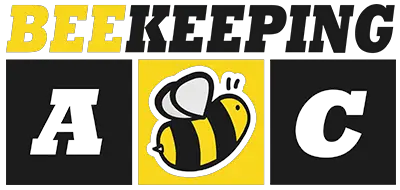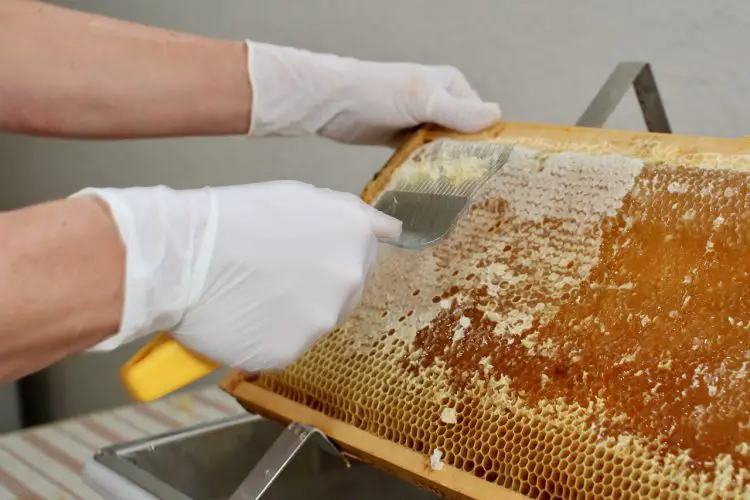In the past, honey was consumed as is, in its natural state. Extracting it destroyed the nest and also made the honey contain impurities and residues of wax.
Today, the use of an extractor makes it possible to get honey without damaging the honeycomb, while also recovering almost all the honey produced. Extractors makes it possible to recycle the frames after the extraction and to put them back, saving work for your bees.
Here’s our beginners guide to extracting honey – along with the equipment needed to do the job right.
Choose your honey extractor
To collect honey deposited by bees on frames, beekeepers use what is called a honey extractor. The frames will be positioned in the extractor and will rotate around an axis. It is therefore the centrifugal force that makes honey come out of the cells. In general, the rotational speed should be gradual.
The choice of your extractor will be directly related to the number of hives you have, the volume of honey you want to extract, but also your budget.
Manual or electric extractors
The manual extractors are equipped with a crank to turn (which requires brute force and strong arms) to rotate the frames installed inside the tank. They are particularly suitable for beginner beekeepers or those with few hives (about 10 hives). In fact, manual extractors are both easy to use and accessible to all budgets.
For specific honey types such as rapeseed and sunflower, the extractors must increase their volume and their efficiency. Using electric extractors is better because of they added powerful engines. They allow for faster honey extraction and less physical effort. Electric extractors are better when beekeepers have a large apiary.
Radial or tangential extractors, what’s the difference?
In radial extractors the frames are positioned in the shape of a star around the axis. In tangential extractors the frames are positioned parallel to the tank. Both types operate on the principle of vertical extraction.
Radial extractors have the advantage of engaging both sides of the frame simultaneously. The honey then ejects continuously and quickly. They are suitable for the vast majority of honey, especially liquid honeys. Radial extractors are mostly used by professional beekeepers because they have the advantage of being able to process a large number of frames simultaneously.
The tangential extractors engage a single face of the frame (which requires you to perform the operation on the other side as well). In this case, the extraction is longer but safer because the grids prevent any deterioration of the frame. They are mostly used for thick honeys that are deemed difficult to extract (rapeseed, heather …). They are particularly appreciated by beginner beekeepers, who have few hives.
As a beginner, you can also use reversible tangential extractors. These types of extractors are good because they allow a tangential extraction that does not require flipping frames at each rotation. The extraction of honey is done quicker and simpler.
Horizontal extraction with continuous extraction chains
More advanced honey producers use what are known as extraction chains. The extraction takes place horizontally, without handling the frames.
It is possible to automate the uncapping system and extract honey continuously. The frames pass into the horizontal axis extractor and are sent to the output conveyor for receiving the extracted frames. The extraction chains save time and energy for the person extracting the honey.
Honey extraction: the key steps
Before placing the frames in the extractor, it is necessary to remove the small film of wax left by the bees. This is called uncapping.
The wax is removed using a knife, known as an uncapping knife. Hold the frame firmly with your hand so that nothing sticks out and you do not get hurt with the knife.
This phase can also be automated, if the beekeeper has an extraction line.
Once the frames are placed in the extractor, turn the crank slowly at first, then faster and faster to extract the honey. The frames must be placed in the extractor in a balanced way so as to not damage them or damage the tank. If you have an electric extractor, also make sure to evenly distribute the frames in the tank. The rotation done by the motor means you can save your energy and spare your arms.
Keep an eye on the extraction of the honey and make sure it falls perfectly into the bucket without any of it being wasted.
When the honey flows out of the extractor, it may contain some wax residue and various debris. The next step is to filter the honey to get rid of all its impurities.
After filtration, the harvested honey should be left to rest for 4 to 5 days at a minimum of 20 C. This is the ripening phase.
During this time, the remaining impurities will form a foam on the surface that’ll be easy to remove.
The extraction room
Extracting honey should be done in a specially prepared room (most people call it the honey house). It is divided into three main parts: the hot chamber where you stored the full rises, the extraction par where you have the extractor and the centrifuge, and the part where the honey barrels are stored for the ripening phase (before setting honey in pots).
The “hot room” is an isolated room, where full racks are stored. Naturally heated by the rays of the sun, it keeps the honey at a temperature around 28 C and thus decreases its viscosity for the purpose of extraction. A semi-automatic extraction line reduces handling. All equipment should be made of food grade stainless steel.
At the honey house, the honey boxes are placed in a room that’s equipped with dehumidifiers. If the ideal humidity level is maintained, the honey will keep for a very long time. This step is much more difficult in tropical countries, where the climate is very humid and is difficult to control. Honey from these countries are often of lower quality and ferment easily (you can see this in honey with bubbles).
Honey with a high moisture content from more humid areas are recognizable by their more liquid state.


![3 Big Mistakes Beginner Beekeepers Make [And How To Avoid Them!]](https://beekeepingabc.com/wp-content/uploads/2020/11/3-mistakes-beginner-beekeepers-make-90x75.jpg)

![Move over ducks, Queen Bees quack too! [Here’s Why]](https://beekeepingabc.com/wp-content/uploads/2020/06/queen-bee-90x75.png)
![The Flow Hive 2 Review [ Vs. The Classic Flow Hive]](https://beekeepingabc.com/wp-content/uploads/2020/02/Flow-Hive-2-90x75.jpg)
![How Bees Fly [10 Facts About How, When, and Why]](https://beekeepingabc.com/wp-content/uploads/2019/12/A-Bee-Flying-90x75.jpg)